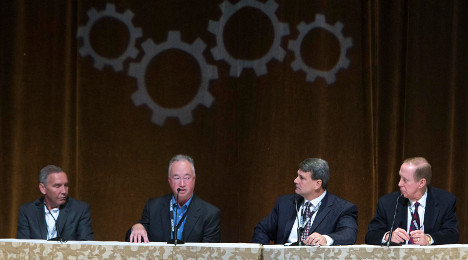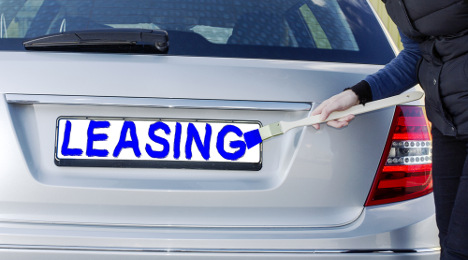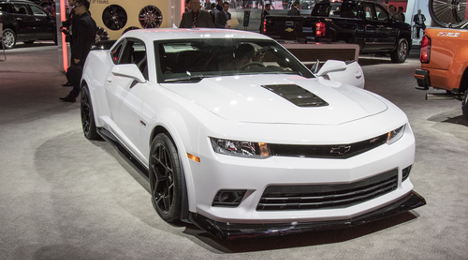During what ended up being another best-ever year for the certified pre-owned business, sales for Big 3, Asian and European brand automakers all increased year-over-year, with domestics notching a double-digit gain.
According to Autodata Corp., there were 926,997 CPO sales by Big 3 brands in 2015, which beat year-ago figures by 11.8 percent.
Asian brands moved 1.18 million certified vehicles, which was up 8.1 percent.
Meanwhile, there were 442,672 CPO sales by European automakers, which was 6.3 percent stronger than 2014 numbers.
Overall, the industry posted 2.55 million CPO sales, which was a 9.1-percent gain, Autodata noted.
Among the Big 3, FCA Group and Ford Motor Co. had record years. Asian brands posting best-ever years were Acura, Infiniti, Kia, Lexus, Nissan, Subaru and Toyota.
European record-breakers were Audi, BMW, Land Rover, Maserati, Mercedes-Benz, MINI and Porsche.
The certified pre-owned market has now posted five straight years of record sales. According to industry sales figures released Wednesday afternoon by Autodata Corp., there were 2.55 million CPO sales in 2015.
Not only was this the best year ever for CPO, but it beat last year’s tally by more than 9 percent, Autodata said.
And more than a few handfuls of automakers reported record years, the company said: Acura, Audi, BMW, FCA Group, Ford Motor Co., Infiniti, Kia, Land Rover, Lexus, Maserati, Mercedes-Benz, Mini, Nissan, Porsche, Subaru and Toyota.
December itself was a solid month for CPO, as well. Four programs — FCA, Infiniti Land Rover and Porsche — achieved all-time highs (December or otherwise) and the overall industry sold 226,967 certified vehicles for the month, which was the best December on record and a 13.1-percent year-over-year improvement.
That capped the best fourth quarter of all time, as the industry moved 624,624 CPO cars for a 4.8-percent hike.
While the final tally for the 2015 full-year sales total has yet to be announced, the certified pre-owned market is expected to post another record year.
In the meantime, here is a sneak peek at how some brands fared in CPO for the year:
BMW moved 115,903 certified vehicles in 2015 (up 12.5 percent year-over-year), and the MINI brand sold 11,621 CPO units (up 23.1 percent).
Porsche reported its best year ever for CPO, moving 14,749 cars.
Mazda sold 39,410 CPO units for the year, down from 43,129 the prior year. Volkswagen had 88,591 CPO sales for 2015, down from 92,520 in 2014.
Volvo sold 19,846 certified vehicles in 2015, up from 14,145 the prior year.
Mercedes-Benz moved 120,509 certified cars in 2015, up from 119,257 in 2014.
CPO sales for Hyundai reached 94,801 units last year, down from 95,486.
Audi had 48,608 certified sales last year, also an all-time high.
You have probably heard this one before, but it bears repeating: there’s going to be a ton of lease returns this year. And you can likely expect to see record certified pre-owned sales again.
But the interesting dynamic to watch in 2016 may be how these two trends mesh and the decisions shoppers will have to make between CPO and new, given the increasing (but still relatively healthy) incentive activity.
Autotrader senior analyst Michelle Krebs, along with Kelley Blue Book senior analyst Alec Gutierrez, addressed these and other auto market happenings during a conference call with the media on Tuesday morning.
Early in the call, Krebs said there will be “a tremendous amount of off-lease vehicles” to hit the used market this year. And you can probably expect to see those cars ending up as CPO units on dealer lots, she said.
And that will bode well for an already record-breaking CPO market.
“It’s a record this year. It’ll be a record next year. It’ll be a record the next year after that,” Krebs said of the CPO market. “That’s what we’re anticipating: a continued upward climb. So, I think the question is, ‘OK, do consumers gravitate more toward CPO cars? Is that going to steal some new car sales?’”
It may be a bit early to answer that, but consider the choices shoppers could be making.
From the consumer standpoint, Krebs said, they may have some additional considerations to weigh when deciding between new and CPO. It’s also important to note the role incentives could play in that decision, she said.
“I mean, they always look at new and nearly new, but there will be more reason to do that,” Krebs said. “And in some cases, if we see incentives continue (to be) high, there may be a reason to buy a new over a CPO. So, it’ll be a really interesting year of which (way) do consumers go in terms of CPO or new.”
Getting into specifics on incentives, Gutierrez said that, historically speaking, the industry remains healthy and there haven't been dramatic spending gains. But he has his eye on the somewhat different paths incentive spend and transaction prices are taking. They’re both up, but incentives are rising faster, he said.
“As far as incentives go and transaction prices, (we’re) definitely still in a good place for the industry in terms of discipline, in terms of strong demand from consumers and willingness to pay a premium price for new vehicles,” he said. “Transaction prices ended the year at around $34,400 overall, about a 1-percent increase year-over-year, while incentive spend on an annualized basis will end the year at around $3,000 per unit, which is up about 4 to 5 percent year-over-year.”
Another key figure to watch? The impact of the new interest rates.
“We know that interest rates were recently increased, so that’s something to watch out for, especially related to leasing and what it does for that business,” Gutierrez said. “From a residual perspective, the market still looks strong, however.”
Generally speaking, industry studies have shown that consumers are willing to shell out a few more bucks for a certified pre-owned car. However, if the consumer is budget-conscious, the price premium on a certified car can be a tricky proposition.
At least that has been the experience for some dealers, including Rod Rowley, who said that led his dealership group and him to believe that “price isn’t the only thing that sells a car.”
Rowley, who is the vice president of new and used inventory at Larry H. Miller Dealerships, was speaking on the Top 10 Best CPO Ideas panel at Used Car Week in November with a few other dealer leaders in the pre-owned space, including his contemporary at another large dealership group.
“Obviously, you’ve got to be valid in the price, you’ve got to be relevant in the price, but what we find more and more are quality comments, quality photos really sell cars,” Rowley said. “They get people’s eyes on the car.”
During the panel, he gave the example of a sign hanging on the office wall of LHM Dealerships’ digital director, which reads: “Where’s the best place to hide a dead body? Page 2 of a search page.”
Rowley added: “So, you’ve got to be relevant with price, but you’ve got to tell the story with the car.”
Telling that story may also mean showing that car’s value, particularly if it’s CPO.
And training your staff to emphasize the value of CPO can be paramount, says Hendrick Automotive Group’s David Nelson, who was also on that same panel along with Auction Direct chief executive officer Todd Hoagey and Don Luke, principal at Bill Luke Chrysler Jeep Dodge Ram (Auto Remarketing’s 2015 CPO Dealer of the Year). LotPop owner Jasen Rice moderated the session.
“In training your staff, let’s face it, that’s absolutely critical, because that’s where the customer interface is,” said Nelson, who is the group’s director of pre-owned operations. “That’s when if they can’t sell the value proposition of a CPO, you’re not going to get paid back for your investment. The hardest thing to do is to get salespeople — believe it or not — to sell the value.
“And so selling the value of the program, getting the ROs, letting them look what was done to the car, having them take pride in the quality, walking the lot. Actually doing those good, old-fashioned things like trade walks, look at it before, and then look at it after when we’re finished with it,” he said.
“It’s a vehicle and a product that you can be proud of, but you’re going to have be able to sell it to make the money,” Nelson added. “So we intensively train on the value propositions of each CPO program that we have.”
Both Nelson and Rowley agreed that using help from the automakers to train the staff in the stores is critical. Nelson also brought up an interesting point about what independents have taught them about selling CPO, as those dealers and others in the industry have built third-party programs to meet the needs of their customers seeking certification.
“They had to develop their own programs to compete with that, and therefore, they developed the expertise of selling against CPO, which really made them better at selling CPO, period,” Nelson said. “And so they’ve really done a good job at driving us to do a better job at selling the certification program.”
Editor's Note: The above Used Car Week video is courtesy of NIADA.TV, which filmed several segments at the conference.
This story is one of several features set to appear in the upcoming January edition of Auto Remarketing, our Leading Dealer Groups issue.
Citing historical trends, NADA Used Car Guide points out that November saw an easing in used-vehicle depreciation, staying the course for the typical seasonal pattern of the industry. November’s depreciation – 1.9 percent – was noticeably lower than October’s 2.7-percent drop.
In the December edition of Guidelines, NADA UCG’s seasonally adjusted used-vehicle price index rose 1 percent compared to last month, to 123.8. Year-to-date, the index falls just 0.2 percent shy of the index’s all-time high averaged last year.
"It's normal for used-vehicle depreciation to slow during the end of the year,” Jonathan Banks, NADA UCG’s executive analyst, said in the analysis. “That said, while the slow is normal for the month, it was steeper than last November's 1-percent slide."
Diving a bit deeper, compact cars saw the biggest hit last month, falling by an industry high 2.7 percent in November, continuing its trend of dropping roughly 3 percent each month for the last seven.
While depreciation for the industry, as a whole, stood at 13.2 percent YTD at the end of November (compared to 12.7 percent for 2014), let’s take a look at all of the segments’ price drops last month, according to NADA UCG:
Change in Wholesale Used-Vehicle Prices – Oct. vs. Nov. 2015
| Segment |
Price Drop Percentage (all values negative) |
| Compact Car |
(2.7) |
| Large Car |
(2.3)
|
| Subcompact Car |
(2.1) |
| Luxury Mid-Size Car |
(2.1) |
| Luxury Compact Car |
(2.0) |
| Industry Average |
(1.9) |
| Mid-Size Van |
(1.9) |
| Luxury Mid-Size Utility |
(1.7) |
| Luxury Compact Utility |
(1.6) |
| Large Pickup |
(1.6) |
| Mid-Size Utility |
(1.6) |
| Compact Utility |
(1.4) |
| Mid-Size Car |
(1.4) |
| Mid-Size Pickup |
(1.1) |
| Luxury Large Car |
(1.1) |
| Large SUV |
(0.8) |
Year-to-date auction volume, by the end of November, stood at 3.83 million units, up 4 percent compared to the same period last year.
Looking forward, NADA UCG predicts that the prices for used vehicles aged zero to 8 years will fall roughly 1 percent in December compared to November. Zooming in to the segment level, the organization also predicts that subcompact and compact cars will drop by 1 percent, more than any other mainstream segment, while both luxury cars and utilities are expected to lose 1 to 1.5 percent in December.
January prices are expected to remain flat before increasing approximately 0.5 percent in February.
With leasing extremely popular with consumers and certified pre-owned models turning at a record pace, a marriage between the two markets came into the conversation again when American International Automobile Dealers Association hosted a webinar on Tuesday, reviewing this year and looking ahead to 2016.
As two of the event’s experts took turns touting the upbeat prospects for both the leasing and CPO markets, Michael Collins of Dealertrack Technologies still wasn’t ready to announce nuptials that might lead dealers and finance companies to cheer during a celebratory reception of moving modestly used metal via a lease.
“I’m not sure banks would consider it,” Collins said about the prospect of CPO leasing gaining a major market share.
“As an old leasing guy from years ago, I certainly would considerate it,” added Collins, who is now senior vice president of lender and F&I solutions at Dealertrack.
Collins did touch on what industry elements need to be in place if CPO leasing ever could gain momentum.
“I think if you’ve got predictability in used-car prices and predictability in supply — and I think we do. With relatively stable pricing, I think a CPO lease opportunity exists,” he said.
“I don’t know how big it is. I don’t know how much the captives may want to go after it. I think it’s there,” Collins added.
Collins went on to mention that new-vehicle leasing is especially important to the industry seeing vehicles roll over the curb in 2016. Experian Automotive reported that leasing accounted for nearly 27 percent of all new-vehicle transactions in the third quarter of this year, up from 24.7 percent the previous year. Collins said he can see that level approaching 30 percent; perhaps even surpassing it.
“It’s a response to wanting to keep monthly payment as flat as we can make them,” Collins said about the industry pulling the leasing lever to put consumers into vehicles.
“This is an industry that is driven by consumers who are driven by payment. There’s no reason in our view why leasing wouldn’t continue to slowly increase,” he added.
ADESA Analytical Services chief economist Tom Kontos also participated in Tuesday’s webinar and agreed about the penetration new-vehicle leasing might generate going forward.
“The prices of new cars continues to go up,” Kontos said. “The demands for that vehicle to have more technology, more safety features, better gas mileage, that all adds to the cost, as well.
“It just makes it more sensible going forward to lease half a car than purchase a whole car for a good portion of the population,” he continued.
Whether it’s leasing a new vehicle — or perhaps one day a CPO model — Kontos maintained how critical the placement of residual values is.
“I distinguish between residual values on lease contract and actual wholesale market values,” he said. “Definitely wholesale market values will have downward pressure.
“The residual values were set three years ago so in terms of residual value losses, that all depends on how the captive finance companies and the banks set their residuals three years ago,” he continued.
“If they set them too aggressively based on the strength of the market two or three years ago, then they’re really going to see some fairly significant residual value losses in 2016 and 2017,” Kontos went on to say. “If they were more conservative and taking into account the growth in volume that was really foreseen back then, then the residual value losses will less notable.”
When it comes to a vehicle’s retained value from new to used, volume is important — but selling more of a vehicle doesn’t necessarily imply its value will stay. Even if the product is spectacular, perceived quality and new quantity sold do not go hand in hand.
This is one lesson that Subaru and Lexus have apparently learned, as both were today named by Kelley Blue Book for the latter’s 2016 Best Resale Value Award winners for best brand and best luxury brand, respectively.
Auto Remarketing chatted with Eric Ibara, KBB’s director of residual values, to see why.
“I guess the simple answer would be that they make great vehicles that people want. There are a lot of brands that make great cars,” Ibara said. “I think what we’ve learned is that making great cars is not sufficient. You also need to manage the way in which vehicles are marketed and sold. And what these brands do very well, I think, is they match their production with the market demands.
“They don’t overproduce the vehicles, and they’re also marketing the vehicles in a way that enhances the value of the vehicles. So they’re not discounting their vehicles to get more volume.”
KBB's 2016 Best Resale Value: Top 10 Cars
| Chevrolet Camaro |
Subaru Forester |
| Chevrolet Colorado |
Subaru WRX |
| GMC Canyon |
Toyota 4Runner |
| GMC Sierra |
Toyota Tacoma |
| Jeep Wrangler |
Toyota Tundra |
And if you take a look at the top-10 list of vehicles from the 2016 model year that KBB expects to retain the highest percentage of their sticker values, you probably won’t be surprised that eight out of the 10 are trucks or utility vehicles. What may surprise you, however, is that five of the vehicles expected to depreciate the least are from domestic automakers.
With four of those five being manufactured by General Motors, we asked Ibara if he was surprised.
“I think that people could be surprised by that. You don’t normally think of domestic brands when you think of vehicles that retain their value,” he said. “But I think that ever since GM went through bankruptcy they really have changed the way in which they approach the market. I sense, and I see, that they’re doing a better job of matching production to demand. They’re not overproducing vehicles and they’ve cut back on the volume of vehicles that they send into daily rental.
“I think these are all good signs but I guess, first and foremost, they’re making vehicles that are very appealing when you see the vehicles that have come to market over the last few years, like the Tahoe and like the Canyon and Colorado,” he continued. “You can see that the vehicles are much improved over what they’ve offered in the past.”
Those with a keen eye that follow KBB’s resale values will notice a first-time inclusion on the list: Tesla.
Ibara says that used-car transaction data for Tesla, up until recent times, was a bit hard to come by. But now that the situation has been rectified, as Ibara put it, KBB is noticing that Tesla’s Model S isn’t seeing as hard a hit in the used market as the rest of the electric vehicle segment is currently experiencing.
“The electric vehicle segment is very interesting,” Ibara said. “We are seeing EVs depreciate much faster than their gasoline-engine counterparts, where one exists. We think it’s a function of the federal tax credit that all these vehicles qualify for and we also think that the early adopters who are buying the electric vehicles want a new car. We don’t see a lot of early adopters gravitating toward used electric vehicles and as a result their depreciation is very steep, for the most part. The Model S is an exception to this rule.”
So what’s a “safe” segment to invest in, as a used-vehicle dealer? KBB expects for trucks and sport utility vehicles to remain popular for years to come — a trend that Ibara says started before oil prices dropped the favorable level they are today.
“We think it’s a trend that will be around for a while,” he said. “Oil is trading around $35 a barrel right now, and there’s really no sign that it’s going to end that streak any time soon. We’re thinking that consumers will continue to prefer sport utility vehicles and that will make them more desirable five years down the road.”
Here's the full list of KBB's 2016 Best Resale Value Awards by vehicle category:
KBB's 2016 Best Resale Value: By Vehicle Category
| SUBCOMPACT CAR: Honda Fit |
PLUG-IN VEHICLE: Tesla Model S |
| COMPACT CAR: Subaru Impreza |
COMPACT SUV/CROSSOVER: Jeep Wrangler |
| SPORTY COMPACT CAR: Subaru WRX |
MID-SIZE SUV/CROSSOVER: Toyota 4Runner |
| MID-SIZE CAR: Subaru Legacy |
FULL-SIZE SUV/CROSSOVER: Chevrolet Tahoe |
| FULL-SIZE CAR: Toyota Avalon |
LUXURY COMPACT SUV/CROSSOVER: Porsche Macan |
| ENTRY-LEVEL LUXURY CAR: Lexus RC |
LUXURY MID-SIZE SUV/CROSSOVER: Lexus GX 460 |
| LUXURY CAR: Lexus GS |
LUXURY FULL-SIZE SUV/CROSSOVER: Lexus LX 570 |
| HIGH-END LUXURY CAR: Porsche Panamera |
HYBRID SUV/CROSSOVER: Lexus RX 450h |
| SPORTS CAR: Chevrolet Camaro LT |
MID-SIZE PICKUP TRUCK: Toyota Tacoma |
| HIGH PERFORMANCE CAR: Chevrolet Camaro SS |
FULL-SIZE PICKUP TRUCK: Toyota Tundra |
| HYBRID/ALTERNATIVE ENERGY CAR: Lexus ES 300h |
MINIVAN/VAN: Toyota Sienna |
Looking back on November’s wholesale results, the picture painted is very much similar to previous months: Average auction prices were up month-over-month but flat year-over-year. And the uptick was largely due to truck prices.
Wholesale vehicle prices in November averaged $9,883, an increase of 1.1 percent compared to October. This was 0.1 percent higher than year-ago figures.
This was reflected in ADESA Analytical Services’ monthly analysis, provided by Tom Kontos, who pointed out in his Kontos Kommentary that the “strong retail demand,” especially in the certified pre-owned area, is what is maintaining the price levels despite the increasing supply.
“In short, data and other analysts are increasingly validating comments made here for many months about inevitable price softness from growing used-vehicle supply,” Kontos said. “Also as noted repeatedly here, the major saving grace keeping prices from falling further and sooner has been strong retail demand, especially for certified pre-owned vehicles.”
Kontos also pointed out that the softer pricing conditions are hitting institutional consigners more than dealers, “who have the option of retailing vehicles and only wholesaling units for which they can obtain attractive sales prices.” He said this advantage was show via strong month-over-month and year-over-year auction performance for dealer consignors.
To that end, the results for November show that the average wholesale prices for used vehicles remarketed by manufacturers were up 3.1 percent month-over-month and 4.3 percent year-over-year — and Kontos drew attention to the fact that, “manufacturers held out for their asking prices by often selling less than 50 percent of the units offered.”
Looking at vehicles in the 3-year-old segment, which Kontos used as a proxy to represent off-lease vehicles, the prices were down 3.2 percent month-over-month in November, and 9 percent year-over-year.
Utilizing data provided by NADA, Kontos showed that used-vehicle sales by franchised dealers increased 4.1 percent year-over-year while independent dealers saw their sales increase by 5.4 percent, both of which were down month-over-month.
According to figures from Autodata, CPO sales decreased by 13.8 percent month-over-month in November and 4.7 percent on a year-over-year basis. Despite that drop, overall sales remain up 8.7 percent year-to-date.
College football bowl games. Your office holiday party. TBS showing “A Christmas Story” on repeat. Predictably, these things happen every December.
Lately, so does this: a used-car market that skews heavily toward certified pre-owned.
December has become the month where CPO’s share of franchised dealer used-car sales is at its annual peak.
In fact, says Edmunds.com, this has happened in seven of the last eight years.
Take December 2014, for instance. Certified vehicles made up 24 percent of used sales for franchised dealers, Edmunds said in an analysis alongside its Q3 2015 Used Vehicle Market Report.
Not only was this the highest CPO penetration of the year, it also currently ranks as the second-highest share of all time, according to the report (The record 25 percent was reached in May of this year).
So, why such strong CPO share in December?
A few factors are at play, says Jessica Caldwell, who is director of industry analysis at Edmunds.com.
For one, the end-of-year has traditionally been strong for luxury car sales, which tends to go “hand-in-hand” with CPO, a segment of the market that was honed on the luxury side before moving more broadly mainstream.
Additionally, she told Auto Remarketing on Tuesday afternoon, many leases wrap up at the end of the year. These cars can be plugged directly into the CPO inventory, so it “makes sense” these cars would be sold as certified units, she said.
Overall CPO strides
In the third quarter, nearly 22 percent of franchised dealers’ used sales were CPO. Never before has the CPO share been that high in Q3, Edmunds said.
Just five years ago, certified share was at 18.4 percent in Q3.
“More and more shoppers are opening their eyes to the benefits of certified pre-owned vehicles,” Caldwell said in the analysis. “These cars offer a unique value proposition to shoppers who want to pay used car prices but demand the peace-of-mind that comes with a new-car purchase.
“And while CPO used to be associated only with expensive luxury brands, we’ve seen every mainstream brand get into the game in recent years,” she added. “With more near-new cars coming off lease and making up a larger chunk of used car supply, shoppers can expect even more CPO vehicles on dealer lots in the coming months and years.”
Edmunds notes in the report that CPO sales are at all-time highs and will only grow in 2016. Caldwell emphasized the connection between leasing and certified, pointing out that with leasing rates as high as 28 percent these days, CPO growth may be on for the “foreseeable future.”
‘Opening their eyes’ to CPO benefits
Going back to Caldwell’s point in the analysis about consumers “opening their eyes to the benefits” of CPO, she emphasized that education and awareness have been crucial in that regard, and that dealers and automakers would be wise to continue those efforts.
Supply also plays a part, Caldwell said. There are more CPO cars available for consumers and with supply increasing, the price proposition for them is also better than when supply was short.
Just how much is CPO resonating with consumers? Consider some of these statistics Edmunds shared from a survey of 2,017 adults.
Eighty-eight percent of those folks said that if they were potentially going used, they would shell out more for CPO. Then among that crowd, 37.8 percent were willing to pay as much as $1,000 more, with 36.9 percent saying they would pay as much as $500 more.












